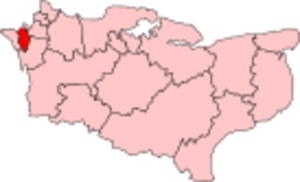Bromley (UK Parliament constituency) facts for kids
Quick facts for kids {{{Name}}}[[{{{Type}}} constituency]] |
|
|---|---|
| [[Image:{{{Map1}}}Constituency.svg|120px|]] [[Image:England{{{Map2}}}.svg|120px|]] |
|
| {{{Name}}} shown within [[{{{Entity}}}]], and {{{Entity}}} shown within England | |
| Created: | {{{Year}}} |
| MP: | {{{MP}}} |
| Party: | {{{Party}}} |
| Type: | House of Commons |
| County: | [[{{{County}}}]] |
| EP constituency: | [[{{{EP}}} (European Parliament constituency)|{{{EP}}}]] |
Bromley was a special area in the United Kingdom that elected a person to speak for it in the House of Commons. This is part of the UK's Parliament, where laws are made.
Like many areas in the 20th century, Bromley chose one person to be its Member of Parliament (MP). This was done using a system called "first past the post," where the candidate with the most votes wins. Bromley was in Kent until 1965, and then it became part of Greater London.
One of the most famous MPs for Bromley was Harold Macmillan. He later became the Prime Minister of the UK from 1957 to 1963.
Contents
What Was Bromley's Area?
The area that the Bromley MP represented changed a few times over the years. These changes are called "boundaries."
- 1918–1945: The area included the town of Bromley itself, plus the nearby areas of Beckenham and Penge.
- 1945–1950: It covered parts of Bromley and Beckenham, and the whole area of Penge.
- 1950–1974: It included just the town of Bromley.
These areas were originally in the northwest part of the historic county of Kent. They became part of Greater London in April 1965. The Bromley constituency was stopped in 1974. The larger area of the London Borough of Bromley was then split into four new areas for Parliament.
A Look Back at Bromley's History
The Bromley area was known for its nice, green suburbs and successful small businesses. Because of this, it was a very strong area for the Conservative Party.
Before 1918, this area was mostly part of the Sevenoaks constituency. The first MP for Bromley was Henry William Forster. He had been the MP for Sevenoaks before. In 1919, he became Baron Forster and later served as the Governor-General of Australia.
After Henry Forster, the next three MPs were chosen in special elections called "by-elections." These happen when an MP leaves their job between general elections.
In 1945, something unusual happened. The MP who had just been elected passed away before the election results were officially announced. This meant there was another by-election. Harold Macmillan, who would later become Prime Minister, was chosen by the Conservative Party to run for this seat. He won and became the MP for Bromley. He served from 1945 until he retired in 1964.
After Macmillan, John Hunt became the MP. He continued to represent the area (which was renamed Ravensbourne in 1974) until 1997.
Who Represented Bromley?
Here are the people who were elected as Members of Parliament for Bromley:
| Election | Member | Party | |
|---|---|---|---|
| 1918 | Henry Forster | Coalition Conservative | |
| 1919 by-election | Cuthbert James | Coalition Conservative | |
| 1922 | Conservative | ||
| 1930 by-election | Sir Edward Campbell | Conservative | |
| 1945 by-election | Rt Hon Harold Macmillan | Conservative | |
| 1964 | John Hunt | Conservative | |
| Feb 1974 | constituency abolished: see Ravensbourne | ||
Images for kids
See also
- List of former United Kingdom Parliament constituencies
| Parliament of the United Kingdom (1801–present) | ||
|---|---|---|
| Preceded by Saffron Walden |
Constituency represented by the chancellor of the Exchequer 1955–1957 |
Succeeded by Monmouth |
| Preceded by Warwick and Leamington |
Constituency represented by the prime minister 1957–1963 |
Vacant
Title next held by
Kinross and West Perthshire |



